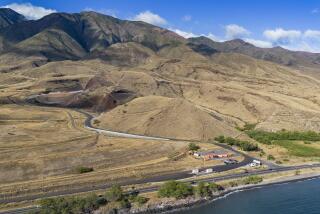Oceanside Puts Compost Plant at Top of Heap Among Sewage Solutions
- Share via
Oceanside city officials, in a time crunch to figure out what to do with the city’s sewage before a San Diego County landfill closes in 1992, are touting their plans for a composting plant on the Whelan Ranch as an environmentalist’s dream come true.
Residents who gathered at a public forum Tuesday at Garrison Elementary School expressed concern about odor, air pollution and ground-water contamination from a waste-water sludge composting plant. But Oceanside Water Utilities Director Barry Martin assured the audience that the system would be completely contained and virtually odorless.
Oceanside, along with other North County communities, has been hurriedly searching for a way to dispose of the solid byproducts of its sewage because the landfill at Otay Mesa, the only landfill in the county that accepts sewage sludge, is expected to be full within three years. A regional North County solution was being sought, but Oceanside decided in late June to go it alone.
Cake-Like Byproduct
Martin said that a tour of several composting facilities nationwide, followed by a six-month practice run of a miniature compost reactor at the San Luis Rey Waste Water Treatment Plant, convinced him that composting is the best route.
After water is squeezed from sewage and recycled for agricultural uses, a cake-like byproduct is left. Oceanside is paying about $500,000 a year to have such sludge trucked to the county landfill.
In the composting process, instead of incinerating or disposing of the sludge, it is mixed with sawdust and broken down in 60-foot-long tunnels. Harmful bacteria are killed by exposing the mixture to high heat, and the resulting organic reaction breaks down the material into a usable soil additive.
City waste-water operations manager Lonnie Thibodeaux assured the group at Tuesday’s forum that, because the entire process takes place in an enclosed, insulated building, no excess heat or pollutants are emitted. Regular, stringent testing would be conducted to ensure that no invisible gases escape from the plant, and “odor scrubbers” would keep the air fresh, he said.
The $8- to $10-million plant would take up 10 acres of a 39-acre parcel of the Whelan Ranch. The rest of the land would be turned into a wildlife conservancy, with reclaimed water from the treatment plant used for irrigation.
The city is planning to build the facility east of Whelan Lake, where a dairy farm now sits. The prospect of the dairy being razed brought applause from the audience at the forum because the ranch has come under increasing fire in recent months to clean up its stench and the cow manure that lines the lake.
A $1.6-million purchase price for the land was proposed last year but rejected by the heirs of the Ellen Whelan estate. Martin said the city will offer an updated price of $2.2 million, but is prepared to acquire the land through condemnation if necessary.
More to Read
Sign up for Essential California
The most important California stories and recommendations in your inbox every morning.
You may occasionally receive promotional content from the Los Angeles Times.










